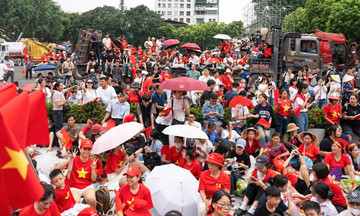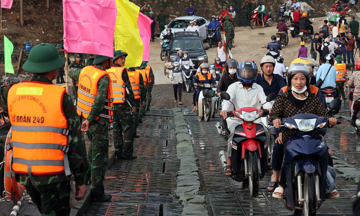The Ninh Binh Provincial People's Committee (UBND) and Xuan Truong Construction Corporation recently proposed building an international airport, potentially located in Y Yen (formerly Nam Dinh province) or at a location suggested by the Ministry of Construction. Funding would come from the Ninh Binh provincial budget and socialized capital. The Ministry of Construction supported the proposal to research and consider adding an airport in this area in the future.
Aviation design expert Nguyen Bach Tung said the advantage of building an airport in Ninh Binh is to boost local tourism and economy. Ninh Binh is a popular tourist destination, known for the Trang An scenic complex, Tam Coc - Bich Dong, Hoa Lu ancient capital, and Bai Dinh pagoda. In 2024, Ninh Binh welcomed more than 8.7 million visitors, and aims to welcome over 9 million, including over 2 million international tourists, in 2025.
Despite the large number of tourists, the province currently lacks an airport, causing inconvenience. Tourists often have to fly to Noi Bai Airport (Hanoi) or Tho Xuan Airport (Thanh Hoa) and then travel by road for 3-4 hours to reach Ninh Binh. "Having an airport will help Ninh Binh welcome more international and domestic tourists, reducing reliance on Noi Bai or Tho Xuan airports," Dr. Tung said.
In addition to serving tourists, the airport in Ninh Binh would also serve the people of the former Ninh Binh province (including the former Nam Dinh, Ninh Binh, and Ha Nam), as well as some residents of Thanh Hoa and southern Hanoi.
 |
A festival at the Trang An heritage site (Ninh Binh) attracts many tourists. Photo: Giang Huy |
A festival at the Trang An heritage site (Ninh Binh) attracts many tourists. Photo: Giang Huy
According to Mr. Tung, an advantage of this project is the participation of businesses investing in the form of public-private partnerships (PPPs), an area that has long been difficult to mobilize socialized capital. Implementing PPPs is also a driving force for private sector development, in line with the spirit of Resolution 68 of the Central Committee.
Supporting the airport planning research, Dr. Luong Hoai Nam, CEO of Bamboo Airways, assessed that Vietnam's airport infrastructure is lagging behind and still struggling with outdated and complex airport development models, while other countries have progressed much further. In the US, for example, even small towns have their own airports funded not by the state budget but by businesses and communities, with open mechanisms allowing citizens and investors to participate.
Many localities with tourism and real estate potential can invest in building small airports as a driving force for economic development. Provinces are not waiting for the state budget and are willing to invest as long as there is a clear legal framework.
However, many experts point out some drawbacks to building an airport in Ninh Binh. The Vietnam airport network plan to 2030, with a vision to 2050, and the Hanoi Capital master plans have identified a second airport for the Capital Region, located south of Hanoi, to be built between 2030 and 2050. Transportation plans and the capital's master plan also identify the proposed location of this airport in the former Phu Xuyen district.
The distance from Y Yen (Ninh Binh) to the Phu Xuyen area is only about 40-50 km, which aviation expert Nguyen Bach Tung considers "quite close." If both airports are built, the risk of sharing passenger and cargo market share is very high. Authorities need to carefully study the development potential of both airports and adjust planning if necessary. If implemented, the province should choose an airport location that doesn't significantly impact rice-growing land and plan early to minimize the impact of future land acquisition.
Dr. Dao Ngoc Nghiem, Vice President of the Vietnam Urban Planning and Development Association, analyzed that the Hanoi People's Committee has decided to build the second airport in Phu Xuyen after 2030 not only to reduce passenger transport load for Noi Bai but also to transport goods, boost the economy, and develop logistics. The airport will be linked to new satellite urban areas, industrial clusters, and craft villages in the south of the capital.
If there is an additional airport in Ninh Binh, 40-50 km from the Phu Xuyen airport, it will have to share passenger and cargo traffic, reducing investment efficiency. "If both are included in the plan, the Ministry of Construction must calculate and determine the construction timeline, scale, and function of each airport to avoid waste," Mr. Nghiem said.
Dr. Tran Quang Chau, Chairman of the Vietnam Aviation Science and Technology Association, is concerned that an additional airport in Ninh Binh might lead to overlapping flight routes and affect airspace with multiple airports in close proximity. Airport planning requires studying not only the location on the ground but also the airspace.
Experts assess that the airport network plan has been carefully studied by the former Ministry of Transport (now the Ministry of Construction), based on criteria such as demand for cargo and passenger throughput; socio-economic development; national defense and security; natural conditions; distance to the central city and neighboring airports; and has been approved by the government.
Airports such as Gia Binh (Bac Ninh), Mang Den (Kon Tum), and Van Phong (Khanh Hoa) are identified as potential airports and can be considered for inclusion in the plan when needed. Ninh Binh airport is not yet on the potential list, so it should initially be developed as a specialized airport (transporting tourists and goods, not regular public transport).
Doan Loan












